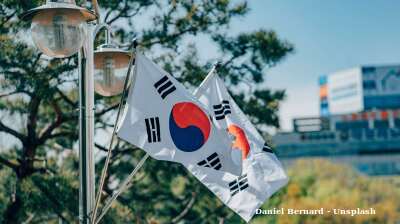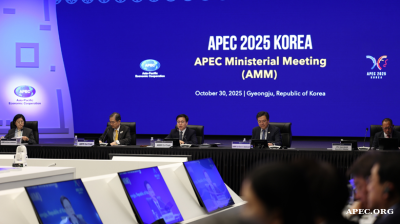South Korea and the United States have reached a significant breakthrough in long-stalled trade discussions, agreeing on the specifics of a $350bn investment package in exchange for a reduction in US tariffs on Korean goods, The Korea Times reports. The agreement was finalised during a summit on the sidelines of the Asia-Pacific Economic Cooperation (APEC) meetings in Gyeongju, where South Korean President Lee Jae Myung met with US President Donald Trump.
Under the accord, South Korea will provide $200bn in cash investments and $150bn for cooperation in the shipbuilding sector, with an annual cap of $20bn. The agreement comes after months of intense negotiations aimed at lowering the US tariff on Korean products from 25% to 15%.
Kim Yong-beom, the South Korean presidential chief of staff for policy, explained that the framework reached during the summit sets out precise mechanisms to mitigate the potential impact of the $200bn cash tranche on Korea’s foreign exchange markets. Rather than disbursing the full sum immediately, the funds will be released incrementally, with a $20bn ceiling per year.
“This phased approach allows the investments to advance in step with project development, ensuring that currency fluctuations remain manageable,” Kim stated. The investment allocation will follow a capital call system, with funds released according to project milestones rather than as a lump sum, helping maintain financial stability and predictability.
According to The Korea Times, the remaining $150bn will be channelled into a shipbuilding cooperation fund, informally named “Make American Shipbuilding Great Again.” This initiative, led by South Korean companies, will include both direct investment and government-backed guarantees. Kim emphasised that the arrangement secures a central role for Korean firms while strengthening strategic industrial collaboration between the two nations.
To ensure the recoverability of investments, the deal incorporates multiple safeguards. Projects must be commercially viable, a condition defined in the memorandum of understanding. Investments will proceed only if a joint committee of South Korean and US officials confirms, on a good-faith basis, that cash flow is sufficient to recoup the capital. Each project will also be overseen by a Korean project manager to maintain accountability and transparency. Additionally, provisions allow Seoul to consult Washington on any unilateral investment actions proposed outside the committee’s remit.
The tariff element of the deal also includes notable concessions. While the July agreement had lowered the blanket US tariff on Korean goods from 25% to 15%, Korean automobiles were previously excluded. The finalised agreement extends the 15% levy to vehicles as well. For other product categories, the US will grant most-favoured-nation treatment to Korean pharmaceuticals and wood products. Certain items, including aircraft components, generic medicines, and natural resources not produced domestically in the United States, will be fully exempt from tariffs. For semiconductors, tariffs have been calibrated to ensure South Korea remains competitive against its main rival, Taiwan.
Kim described the arrangement as “mutual concessions” designed to reinforce industrial collaboration and stabilise supply chains between the two countries. In addition, both governments agreed to maintain protective measures in the agricultural sector, particularly limiting market access for sensitive products such as rice and beef, while enhancing communication on quarantine and sanitary standards.
The path to the agreement involved extensive follow-up discussions since the initial July framework. These consultations included 23 ministerial-level meetings and numerous working-level sessions between South Korea’s Ministry of Trade, Industry and Energy and the US Department of Commerce, as noted by The Korea Times. Kim noted the intensity of the process, highlighting that President Trump praised Trade Minister Kim Jung-kwan as a “tough negotiator.” In the final stages, Kim himself held three direct meetings with US Commerce Secretary Howard Lutnick, reflecting the high level of commitment from both sides to secure a comprehensive resolution.
Jason Tuvey, an economist at Capital Economics, commented that based on the details released so far from the Korean side, the deal appears relatively favourable. The reduction in auto tariffs and the structured investment approach are likely to avoid significant downward pressure on the South Korean won. He added that the agreement slightly improves Korea’s economic outlook and reinforces expectations that the Bank of Korea is unlikely to pursue further monetary easing for the remainder of the year.
News

Viktor Orban facing delicate balancing act to persuade Donald Trump to ease pressure on Hungary over Russian sanctions
The Hungarian prime minister, long admired in MAGA circles and hailed by Donald Trump as a “great leader” now finds himself for the first time at odds with the US president over the latest US sanctions on Russia.

Trump–Xi dialogue in Busan aims to cool tariff dispute
US President Donald Trump and Chinese President Xi Jinping began direct discussions on October 30, marking their first in person meeting since Trump returned to the White House.

South Korean parties clash over tariff deal with the United States
The Democratic Party has celebrated the deal as a diplomatic success that protects national interests, while the conservative People Power Party argues that the government misled the public about the scale of South Korea’s cash investment in the US

Hasina says supporters to boycott Bangladesh election
Hasina asserted that millions of her and Awami League’s supporters are expected to boycott the upcoming 2026 national polls after authorities barred the party from taking part.


